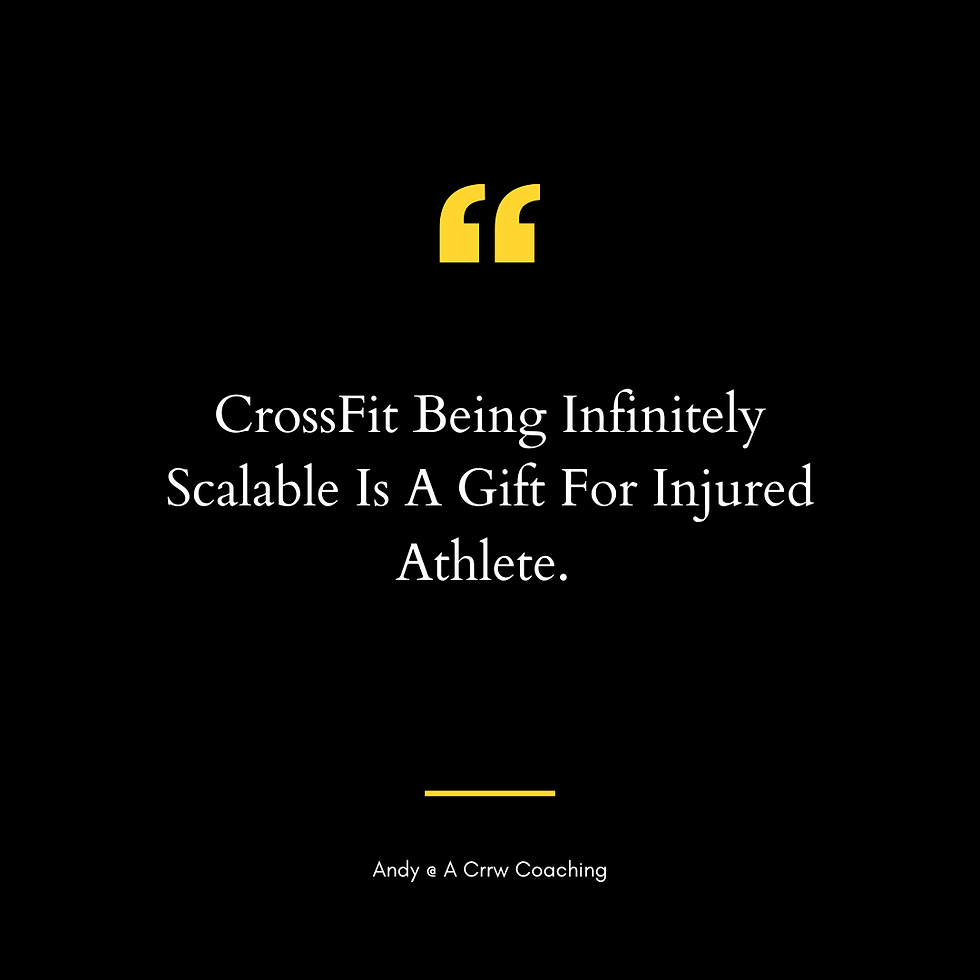CrossFit Being Infinitely Scalable Is A Gift For Injured Athletes
- a-crewandy
- Aug 5, 2024
- 3 min read
CrossFit Being Infinitely Scalable Is A Gift For Injured Athletes
I have been dealing with a couple of injuries recently. A pretty bad flare up of achilles Tendonitis, which is something that comes and goes for me especially in period where there has been some higher volume running. And a wrist injury, sustained when moving awkward and heavy things whilst moving house (no I didn't get injured doing CrossFit). Despite those injuries I have still been going to a number of CrossFit classes and something that has really stood out is just how scalable CrossFit can be.
You see it all the time, the classic video of someone doing a pull up, another doing a banded pull up and someone else doing a ring row. That almost feels like the basics, the things we see and deliver on a daily basis. Working around injuries is a different beast all together. How can we maintain the same or similar stimulus when one of the movements is completely out of the question? If you take my wrist injury as an example, which hurts under flexion, making anything in the front rack position with a barbell not advisable (on the morning or writing it was hurting with a PVC Pipe doing muscle cleans). The dumbell however, no pain what so ever, so switching to a double dumbbell snatch, great. But what if it was a shoulder injury that prevented me from going overhead? Maybe Russian KB swing could be substituted in. What about a back injury that prevents hinging? Could we change it to a combination of upright rows and strict press? Well the answer to that is yes and it's a scenario I had when coaching the very next morning and it was one that worked well.
What I am trying to say without droning on is that there is always an answer to the question.
One of the joys and challenges when coaching is to try and find the right option, because there are also plenty of wrong ones, or ones that are not as effective as others. The additional challenge we have is that once people find a scaling option that they are happy with and enjoy (potentially more than the movement that we are scaling from) then it is easy for them, as the individual, to simply just opt for it and for us as coaches to let them. There is a really good video from a Level 2 course where Rob Lawson talks about getting stagnant with scaling options which is a video that really makes you think (https://www.instagram.com/reel/C7WkX2txIdu/?utm_source=ig_web_copy_link&igsh=MzRlODBiNWFlZA==). Trying to convince someone to do something new and uncomfortable, even if it will be beneficial for them, can be a real challenge. Explaining the benefit in the moment, halfway through a class or workout, is even more of a challenge. Where I can I like to try and give different scaling options at the start of the class, varying them from ones I know I have given recently to try and get ahead of it but there are always the occasions where you need to think on your feet (and of course the odd one that will stump you and make you think for a minute or two).
Ultimately for both athletes and those new to CrossFit, seeing really is believing with it. No matter how many times we shout about it, there will be a huge amount of people who do not believe that CrossFit is infinitely scaleable which makes them, at best, nervous to show up and start a class and at worst a complete turn off. What we can do is keep shouting about it and showing it on a day to day basis by actively making sure that as coaches we practice giving people different scaling options consistently, not resting on our laurels, making the occasions that stump us further and further apart with the more experience we gain.
Andy






Comments